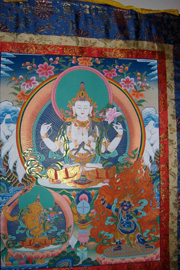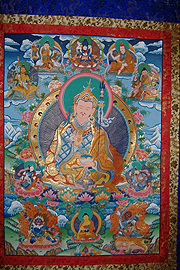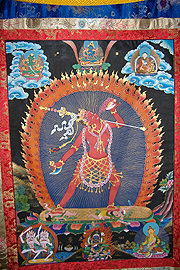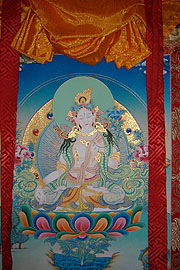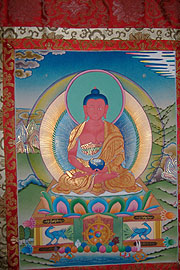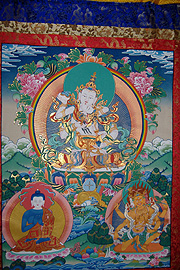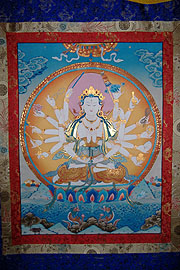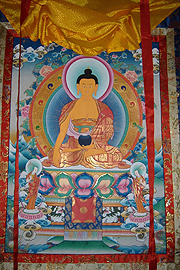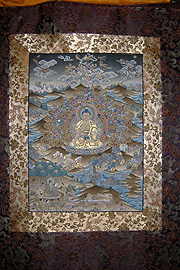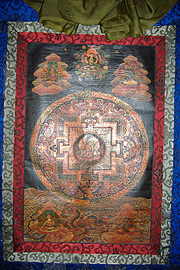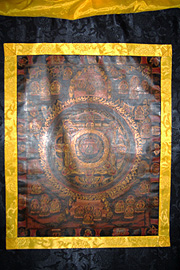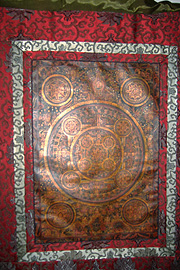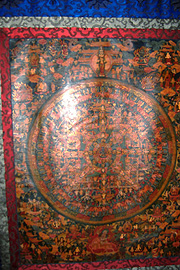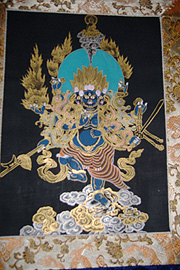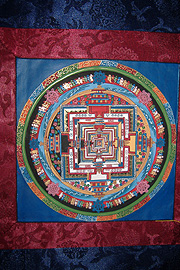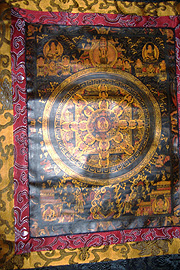|
THE SUBLIME SYMBOLISM OF THANGKA PAINTINGS An exhibition of Tibetan Buddhist Thangka paintings. |
| |||||||||||||||||||||||||||||||||||||||||||||||||||||||||||||||||||||||||||||||||||||||||||||||||||||||||||||||||||||||||||||||
Representation
: Johnes Ruta, (203) 387- 4933 | ||||||||||||||||||||||||||||||||||||||||||||||||||||||||||||||||||||||||||||||||||||||||||||||||||||||||||||||||||||||||||||||||
Art
Theorist/ Curator New Haven Public Library | ||||||||||||||||||||||||||||||||||||||||||||||||||||||||||||||||||||||||||||||||||||||||||||||||||||||||||||||||||||||||||||||||
http://azothgallery.com | ||||||||||||||||||||||||||||||||||||||||||||||||||||||||||||||||||||||||||||||||||||||||||||||||||||||||||||||||||||||||||||||||
All
Thangkas are individually hand-painted on linen canvas, bordered
with hand-embroidered saffron-, silver-, red- or blue-dyed silk brocade, | ||||||||||||||||||||||||||||||||||||||||||||||||||||||||||||||||||||||||||||||||||||||||||||||||||||||||||||||||||||||||||||||||
Each Thangka is prepared on a layer of gesso, and created with ground mineral-pigments, including 24 carat Gold, Silver, Azurite and Lapis Lazuli blues, Cinnabar and Vermillion reds, Ochre yellow, Minium orange, Malachite green, Calcium and Cadmium whites, and Carbon black. | ||||||||||||||||||||||||||||||||||||||||||||||||||||||||||||||||||||||||||||||||||||||||||||||||||||||||||||||||||||||||||||||||
Each
Thangka painting measures approximately 3 feet in width and 4 feet in height. | ||||||||||||||||||||||||||||||||||||||||||||||||||||||||||||||||||||||||||||||||||||||||||||||||||||||||||||||||||||||||||||||||
Please
Click on each image for a larger Thangka display with narrative story. | ||||||||||||||||||||||||||||||||||||||||||||||||||||||||||||||||||||||||||||||||||||||||||||||||||||||||||||||||||||||||||||||||
| ||||||||||||||||||||||||||||||||||||||||||||||||||||||||||||||||||||||||||||||||||||||||||||||||||||||||||||||||||||||||||||||||
| The Tibetan word thangka means "rolled up," because this art is painted on flexible material-cotton or silk that can easily be rolled up for transport. Thangkas are used in processions, and monks carry their personal thangkas with them when visiting other monasteries. Their purpose is not to decorate otherwise empty walls but to serve as aids to ritual worship and meditative visualization, which is at the heart of Tibetan Buddhist spirituality. The finished painting is usually but not always placed in a frame of brocade, which further emphasizes the sacred nature of a thangka. The ideals of the good and the beautiful-spiritual life and art-have a long intertwined history that goes back to the Paleolithic. We can see the extraordinary relationship between the pursuit of spiritual realization and aesthetic expression most strikingly in the Buddhist art of Tibet. Thankas are portable paintings or, more rarely, embroideries depicting mainly Buddhist deities (Buddhas, Bodhisattvas, and Protectors) and venerated lineage teachers (lamas) in a highly symbolic landscape. These figures are typically seated or standing on lotus thrones, holding or surrounded by their characteristic emblems from vajra (dorje) symbol, hand bell, cymbals, conch, begging bowl, canonical manuscripts to staff, ritual sword, dagger, trident, and bow and arrow. The landscape itself either represents one of the heavenly realms or a transfigured earth at the intersection between material and spiritual reality. It is populated by puffy clouds "like white curd," mountains, valleys, trees and other vegetation, lakes, monasteries, pagodas, birds, fish, land animals, auspicious signs (of which there are eight), offering bowls, and not least disciples in a prayerful attitude. Buddhas and Bodhisattvas, as well as lineage masters have halos and often also body nimbuses, whereas fierce protector deities such as Mahâkâla or Kâlarûpa are surrounded by a circle of flames. Some thankas feature mandalas or circular sacred spaces occupied by the main deity in the center, protector deities in the four directions, and often a host of other celestial beings outside the inner circle of the geometric construct. A mandala is a cosmogram, an idealized map of the larger universe. Psychologically speaking, it is a tool for integration. Spiritually speaking, it is a device for focusing the mind in meditation. All thangka imagery shares in this mandalic quality and function. from "The Sacred Art of Thangka Painting" by Georg Feuerstein
| ||||||||||||||||||||||||||||||||||||||||||||||||||||||||||||||||||||||||||||||||||||||||||||||||||||||||||||||||||||||||||||||||
Exhibition
produced in association with LUCKY THANKA GALLERY, Kathmandu, Nepal. Director: NARAYAN K. SHRESTHA. ltthanka@wlink.com.np. www.luckythanka.com | ||||||||||||||||||||||||||||||||||||||||||||||||||||||||||||||||||||||||||||||||||||||||||||||||||||||||||||||||||||||||||||||||
New
haven free public library Gallery 133 Elm street, New Haven, Connecticut | ||||||||||||||||||||||||||||||||||||||||||||||||||||||||||||||||||||||||||||||||||||||||||||||||||||||||||||||||||||||||||||||||
Exhibit:
October 18 to December 3, 2005 | ||||||||||||||||||||||||||||||||||||||||||||||||||||||||||||||||||||||||||||||||||||||||||||||||||||||||||||||||||||||||||||||||
|
PUBLIC RECEPTION: Saturday, October 22,
2005, 2:30 - 4:30 PM | ||||||||||||||||||||||||||||||||||||||||||||||||||||||||||||||||||||||||||||||||||||||||||||||||||||||||||||||||||||||||||||||||
Inquiries
: Please contact Gallery Curator: Johnes Ruta, (203) 387- 4933 | ||||||||||||||||||||||||||||||||||||||||||||||||||||||||||||||||||||||||||||||||||||||||||||||||||||||||||||||||||||||||||||||||
http://azothgallery.com | ||||||||||||||||||||||||||||||||||||||||||||||||||||||||||||||||||||||||||||||||||||||||||||||||||||||||||||||||||||||||||||||||
